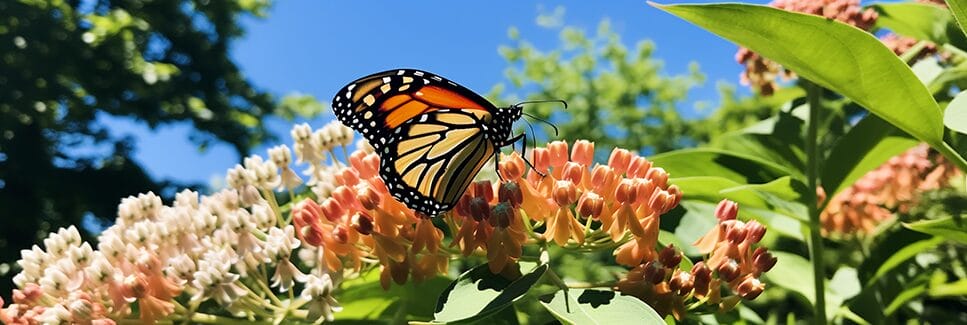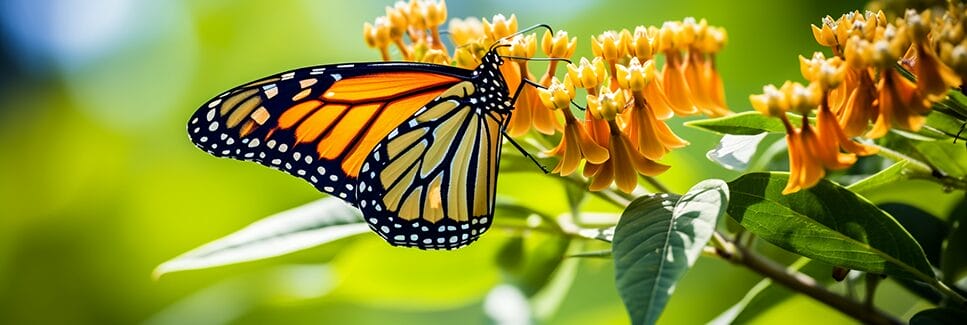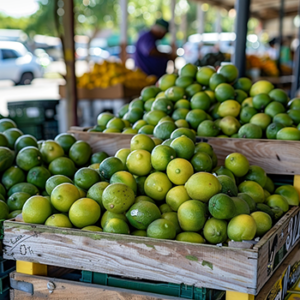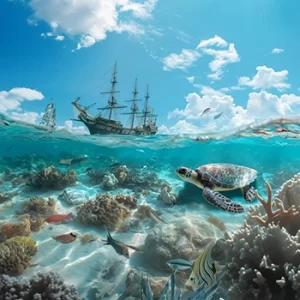
Florida Native Plants for Butterflies
Did you know that Florida’s incredible butterfly diversity, over 200 species, relies on a surprising partner for their survival – plants? Most people don’t think about the importance of butterflies or the plants they need, but for some species… it’s life or death!
Many butterfly species depend on very specific plants, not just for flower nectar, but for the entire lifecycle of their young.
Sadly, with the prolific use of weed killer and chemicals plus the ever-expanding habitat loss and changing landscapes, many of these crucial plants are disappearing, threatening butterfly populations.
By planting native butterfly-friendly plants and gardens, we can all help provide a safe haven for these beautiful creatures.
Want some suggestions of Florida native plants for butterflies to plant in your backyard or in a patio container? Read on!
Florida Butterfly Dependence on Native Plants
Butterflies start as eggs, then transform into caterpillars, pupae, and finally emerge as adult butterflies. Throughout this life cycle, butterflies rely on native plants.
Adult butterflies feed on nectar from flowers, while caterpillars feed on specific host plants. By planting native plants that serve as host plants for butterfly larvae, we can support their life cycle and ensure their survival.

10 Florida Native Plants Crucial to Butterflies:
Want to help Florida’s butterfly populations? Here are 10 plants with growing information you may want to consider planting. Some can even be planted in containers and grown on a small patio!
1. Milkweed (Asclepias syriaca, Asclepias incarnata +)
Milkweed is a perennial flowering small plant known for its milky latex and bright flower clusters. There are many varieties of milkweed including common milkweed, scarlet, Mexican and more. Most common flower colors are bright oranges and yellows as well as pinks and whites.
Milkweed is essential for the survival of Monarch butterflies, as it is the only plant that their larvae can feed on. Without milkweed, monarch butterflies die.
- Zones: 8-10
- Difficulty: Easy to moderate
- Butterflies: Monarch, Queen, Soldier
- Why: Milkweed is the sole food source for Monarch butterfly caterpillars. Its toxic properties make them unpalatable to predators, protecting the next generation of butterflies. Without milkweed, baby butterflies die!
2. Florida Willow (Salix floridana)
The Florida willow is a native shrub that is considered a small, slender tree that can grow to approximately 12 feet tall. This species is facing endangerment.
It grows in central and north Florida where there is moist swampy or mucky soils and in hammocks and by rivers and springs. It has yellowish flowers (catkins) that bloom from February to April.
- Zones: 8-10
- Difficulty: Moderate (prefers moist soil)
- Butterflies: Viceroy, Gray Hairstreak
- Why: The Florida willow provides a crucial food source for Viceroy butterfly caterpillars. The female Viceroy lays her eggs on the underside of willow leaves, and the caterpillars feed on the foliage. While not as widely used by butterflies for nectar as some other plants, its presence is essential for the survival of the Viceroy population in Florida.
3. Firebush (Hamelia patens)
The firebush shrub produces vibrant red flowers that attract a variety of butterflies, including the Zebra Longwing and the Gulf Fritillary. It’s easy to grow and be grown from seed or cuttings. Bonus, hummingbirds love firebush as well as other birds.
- Zones: 9-11
- Difficulty: Easy
- Butterflies: Zebra Longwing, Queen Alexandra’s Spicebush Swallowtail, Gulf Fritillary
- Why: Firebush offers clusters of tubular orange flowers rich in nectar, perfect for butterflies with long proboscises.
4. Partridge Pea (Cassia fasciculata)
The partridge pea plant is a weedy looking plant that has bright pretty yellow flowers. This isn’t a plant you want to grow if you have pets as it is considered toxic to dogs.
It is, however, very important to multiple species of butterflies!
- Zones: 8-11
- Difficulty: Easy
- Butterflies: Cloudless Sulphur, Hairstreaks, Skippers, Little Yellow
- Why: Partridge Pea boasts bright yellow flowers favored by many butterfly species. It’s also a nitrogen-fixing plant, improving soil quality.
5. Spurred Butterfly Pea (Centrosema virginianum)
This is a pea plant so there is a pod. While the fruit inside this pea pod isn’t edible for humans, it’s a source of food for lots of Florida wildlife.
Butterfly pea flowers are a popular source for human tea in dried form, and in powder form is used for natural food coloring and antioxidants and all sorts of other natural things.
- Zones: 8-11
- Difficulty: Easy
- Butterflies: Skippers, Cloudywing
- Why: Butterfly Pea produces clusters of showy purple flowers with readily available nectar for butterflies. It’s also a low-growing vine, ideal for containers.
6. Blanketflower (Gaillardia pulchella)
Blanketflower (Gaillardia pulchella): The bright orange and yellow flowers of this plant are a favorite of the Painted Lady and the American Lady butterflies.
- Zones: 8-10
- Difficulty: Easy
- Butterflies: Buckeyes, Checkerspots
- Why: Blanketflower displays long-lasting daisy-like blooms in shades of red, yellow, and orange, attracting butterflies with their bright colors and abundant nectar.
7. Saw Palmetto (Serenoa repens)
- Zones: 8B-11
- Difficulty: Moderate (prefers well-drained sandy soil)
- Butterflies: Palmetto Skipper and Monk Butterflies
- Why: Saw Palmetto is the host plant for several rare butterfly species. The tiny caterpillars feed on the underside of its fronds.


8. Passionflower (Passiflora incarnata)
Commonly called “Maypop”, this beautiful intricate flowering plant attracts butterflies such as the Gulf Fritillary and the Zebra Longwing.
Bonus: this flowering vine produces delicious passion fruit late fall of each year. Passion fruit makes great milkshakes, smoothies and cocktails!
- Zones: 8-11
- Difficulty: Easy to moderate
- Butterflies: Fritillaries, Longwings, Zebra Heliconia Butterfly
- Why: Passionflower’s unique, fragrant flowers provide nectar and pollen for butterflies. The intricate flower structure also offers shelter for them.
As an Amazon Associate I earn from qualifying purchases at no additional cost to you.
6 Steps to Creating Your Butterfly Garden with Florida Native Plants
There are a few other Florida Native Plants for butterflies that are considered poisonous, like the partridge pea on this list. Be careful to avoid these especially if you have pets that have access to the area where you plant your native plants.
Creating a butterfly garden with native plants is a rewarding way to support butterfly conservation.
Here is a step-by-step guide to get started:
1. Research native plants: Identify the native plants that grow in your particular Florida hardiness zone. If you aren’t sure what zone you live in, check the USDA Plant Hardiness Zone chart here… it goes by zip code.
Once you know your zone and which plants will grow best where you live, analyze the spaces where you’d like to grow your native butterfly plants. Does it get full sun? Partial sun? Hint: most native butterfly plants need full sun during the day.
Figure out what the plant requirements are (amount of sun, amount of water, space) and match the best plants to your spaces.
2. Plan your garden: Design your garden layout, considering the different heights and colors of the plants. Include a variety of nectar-producing flowers and host plants for butterfly larvae.
3. Prepare the soil: Ensure that the soil is well-drained and fertile. Remove any weeds or non-native plants that may compete with the native species.
4. Plant your garden: Dig holes for each plant, ensuring they are spaced appropriately. Water the plants thoroughly after planting.
5. Provide water sources: Butterflies need water for drinking and puddling, so include shallow dishes or birdbaths with rocks for them to perch on.
6. Maintain your garden: Regularly water, weed, and prune your garden to keep it healthy and attractive to butterflies. Avoid using pesticides that can harm butterflies and other beneficial insects.
FAQs
What are Florida native plants?
Florida native plants are plants that are indigenous to Florida and have adapted to the state’s climate, soil, and other environmental conditions.
Why are Florida native plants important for butterflies?
Florida native plants are important for butterflies because they provide food and habitat for them. Native plants have co-evolved with native butterflies and are better suited to meet their needs than non-native plants.
What are some examples of Florida native plants that attract butterflies?
Some examples of Florida native plants that attract butterflies include milkweed, goldenrod, black-eyed Susan, blazing star, and wild indigo.
How do I choose the right Florida native plants for my garden?
To choose the right Florida native plants for your garden, consider the amount of sunlight and water your garden receives, as well as the soil type. You can also consult with a local nursery or gardening expert for advice.
How do I care for Florida native plants?
Florida native plants generally require less maintenance than non-native plants. They are adapted to the state’s climate and soil conditions, so they are more resistant to pests and diseases. However, it is still important to water them regularly and provide them with the appropriate amount of sunlight.
You may also like:






















